Ilya Repin, one of the most accomplished and renowned painters and artists, led a fascinating life. He initiated his education in topography, subsequently transitioning to painting icons. Despite initially failing his first attempt to gain admission to the Imperial Academy of fine Arts in Saint Petersburg, he later became professor of this Academy and produced paintings for the emperor. Isn’t that a fascinating career?
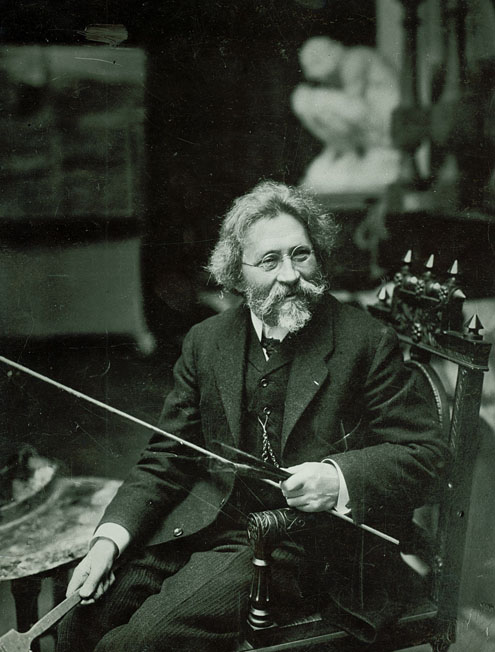
Early years, first failure and first success
Ilya Repin was born in a wealthy family in Chuguev. His artistic career was inspired by his brother who used to bring paints home and encouraged Ilya to create his first drawings and pictures. At the age of 11 he was sent to a school of topography, a popular profession in his hometown. However the school closed up after two years and Ilya, who already decided to become a professional artist, applied for an apprenticeship in an icon painting studio. He was impressed by his teacher, hereditary icon painter Ivan Bunakov, from whom he had learnt a lot. Ivan Bunakov noticed and appreciated the talent of his student. Bunakov even sent Repin, along with other icon painters, to work in various cities. At the age of 16 Ilya Repin was determined to receive a formal education and attempted to gain admission to the Imperial Academy of fine Arts in Saint Petersburg, but he didn’t succeed. Although this was a huge disappointment for a young man, he refused to return to his hometown. He stayed in Saint Petersburg, preparing for the exams again. After the second attempt he successfully gained admission to the Academy.
During his studies Ilya Repin got acquainted with famous painters, such as Ivan Kramskoi, Vasily Polenov and critic Vasily Stasov. However, the young painter faced financial struggles at the beginning of his career due to insufficient payments for his genre painting and portraits. In 1869 he made a portrait of Vera Shevtsova, who later became his wife.
His professional career experienced a positive turn too. For his graduation work at the Academy of Arts Ilya Repin chose a scene from the Bible, Resurrection of the Daughter of Jairus. His work earned him a Gold Medal and the opportunity to go to the West to study European art.
Ilya Repin as a mature artist
The primary focus of Repin`s artwork was to depict the authentic life of Russian folk as well as the scenes from the Bible. In 1870 Ilya Repin, along with two other painters, embarked to a journey to the Volga River value where he did sketches. As a result of this trip in 1873 Repin unveiled one of his most famous works, ‘Barge Haulers on the Volga’. This painting was exhibited at the Vienna International Exposition, bringing Repin international acclaim. Following the exposition he spent two years in Paris, where he produced ‘A novelty seller in Paris’, ‘A Paris Café’ and other renowned artworks.
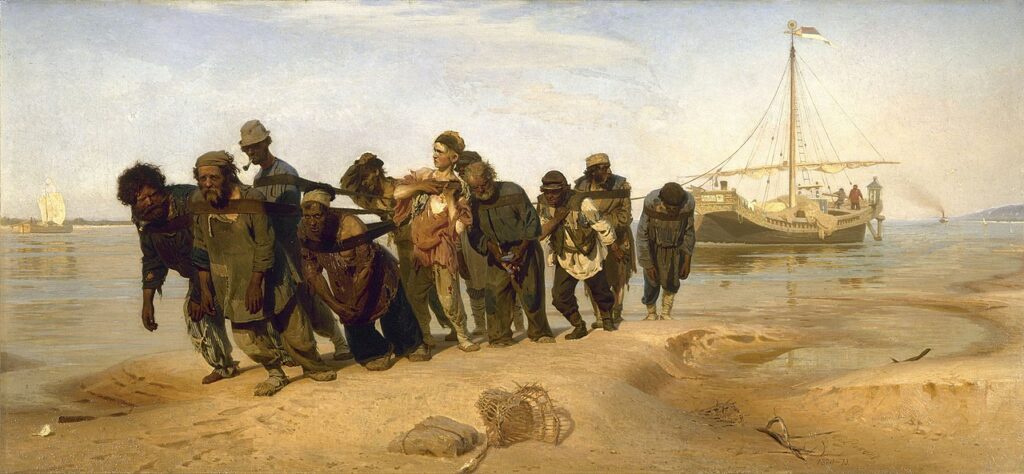
Barge Haulers on the Volga. Source: Wikipedia
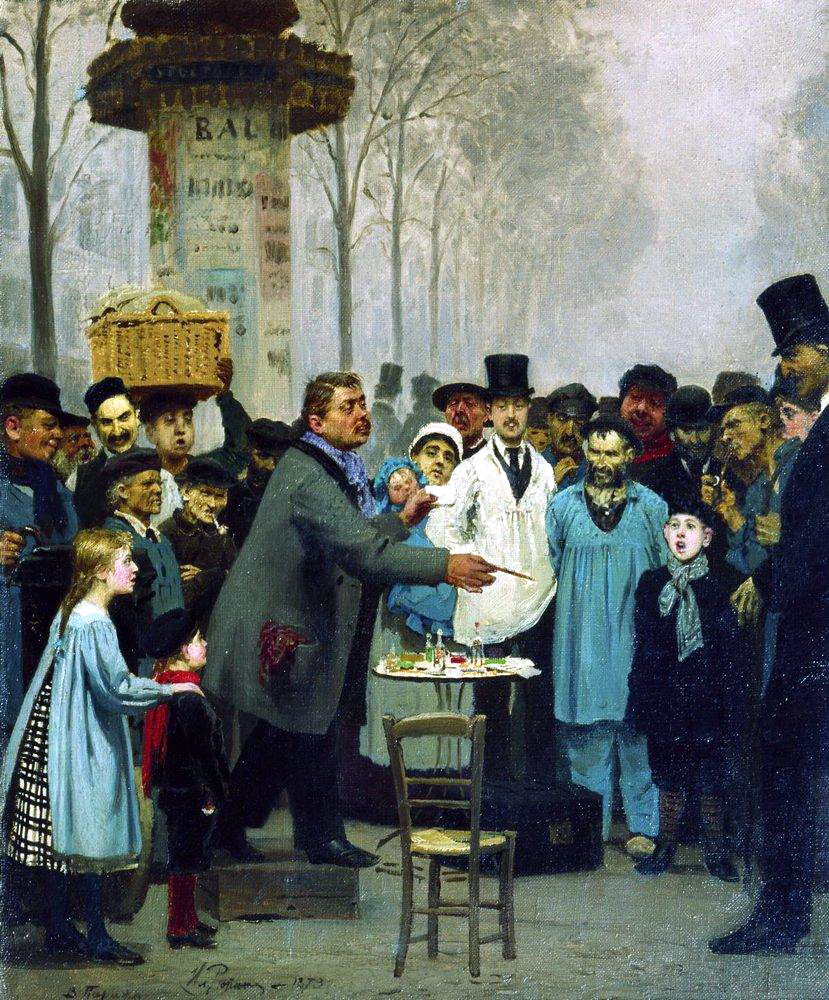
A novelty seller in Paris. Source: Wikipedia
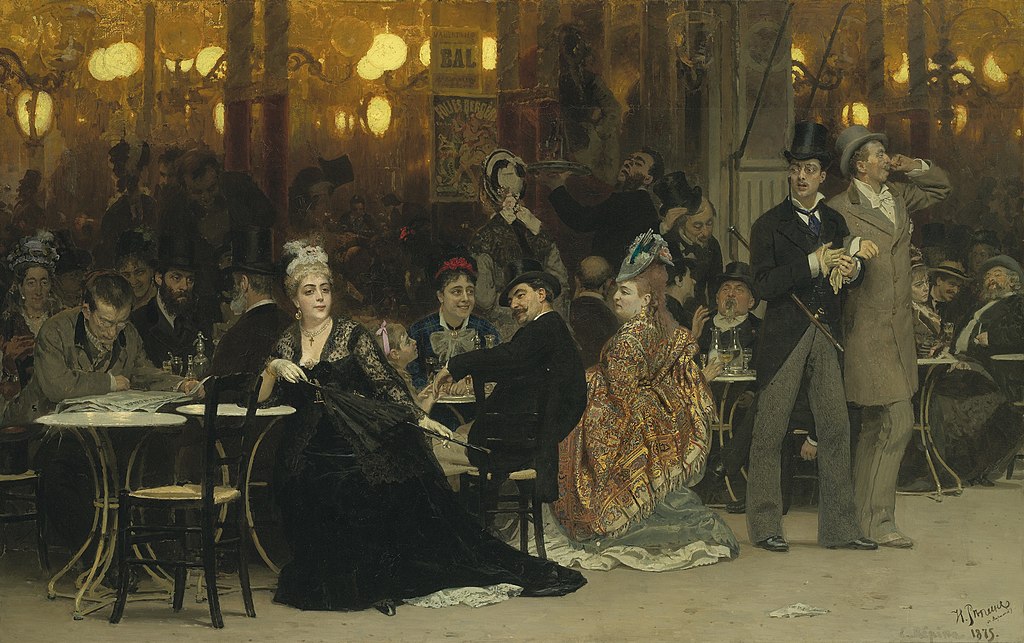
A Paris Café. Source: Wikipedia
In 1876 Ilya Repin returned to Moscow as a well-known painter. During that time, there was a prominent artistic movement known as ‘Peredvizhniki’ or ‘The Wanderers’ who aimed to disseminate culture and art to the Russian provinces and educate people to understand and appreciate art. The art of ‘Peredvizhniki’ was characterized by realism and a strong political engagement. Repin joined this movement and supported its members.
His personal work life reached its pick during these years. After he became acquainted with Leo Tolstoi, Ilya Repin created one of his largest paintings known as ‘Religious Procession in Kursk Governorate’ or ‘Easter Procession in the District of Kursk’. This painting was remarkable for its exceptionally realistic depiction of the figures of surly policemen, weary monks, children and beggars, each displaying a vivid personality. Repin also experimented with capturing outdoor sunlight effects.
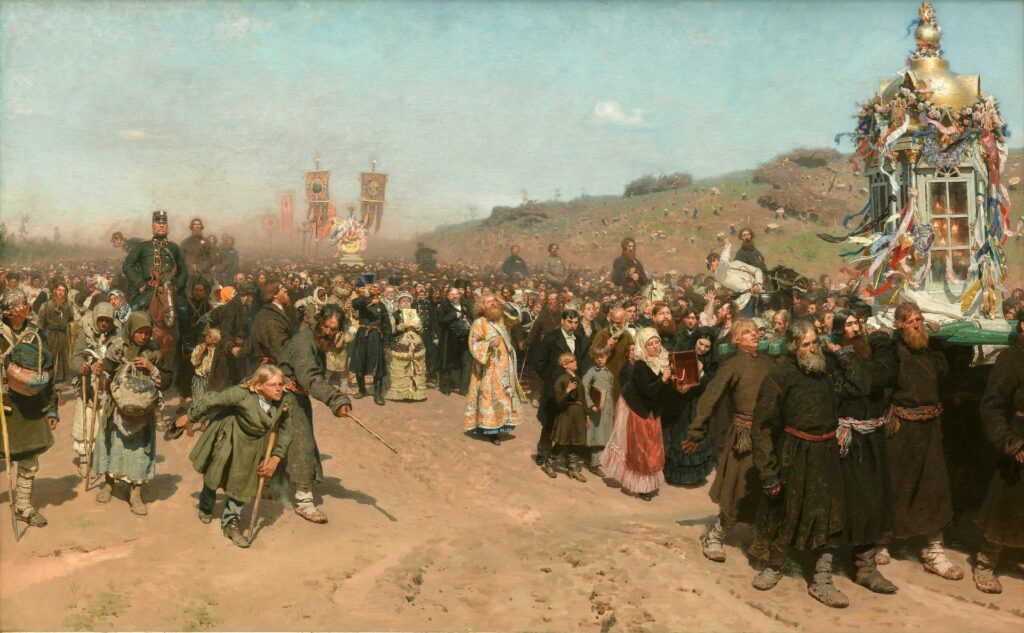
Religious Procession in Kursk Governorate. Source: Wikipedia
On one occasion Ilya Repin visited a concert of Nikolai Rimsky-Korsakov and was inspired by the music he heard. He decided to create a drawing «that could be as compelling as the music of Rimsky-Korsakov». One of the most expressive works of Ilya Repin ‘Ivan the Terrible and His Son Ivan on 16 November 1581’ was a response to this musical experience and provoked many discussions.
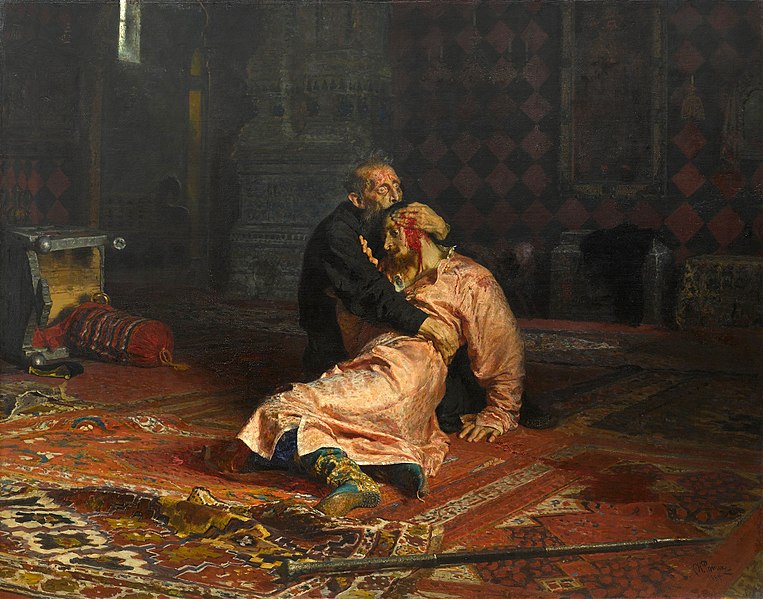
Ivan the Terrible and His Son Ivan on 16 November 1581. Source: Wikipedia
It’s worth mentioning, that Pavel Tretyakov, Russian businessman, patron of fine art, who assembled a remarkable collection of artworks for the collection of the Tretyakov gallery in Moscow which is now recognized as the largest collection of the Russian art and culture, was deeply impressed by Ilya Repin’s paintings and acquired many of them. However, Repin’s true masterpiece, the painting ‘Reply of the Zaporozhian Cossacks’ was too expensive for him to acquire. The emperor Alexander III acquired the painting and placed it in the Russian Museum in Saint Petersburg as he was well-known for his enthusiasm for Russian culture. Additionally, the emperor commissioned Ilya Repin to create a special picture for a specific occasion. In 1903 Ilya Repin presented his enormous canvas ‘Ceremonial Sitting of the State Council on 7 May 1901 Marking the Centenary of its Foundation’ (400 cm x 877 cm), which is now exhibited in the Russian Museum in Saint Petersburg.
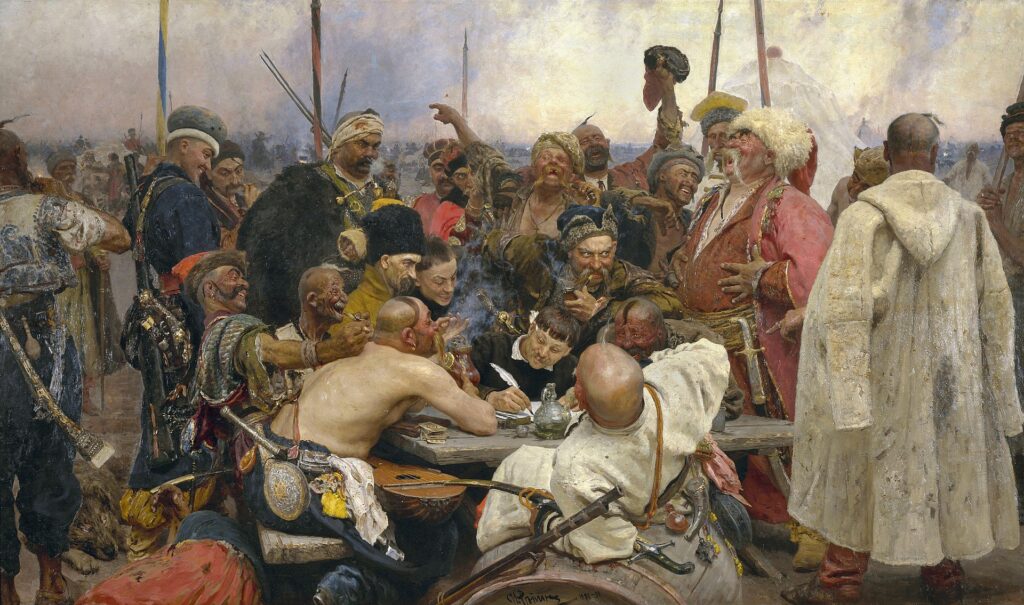
Reply of the Zaporozhian Cossacks. Source: Wikipedia
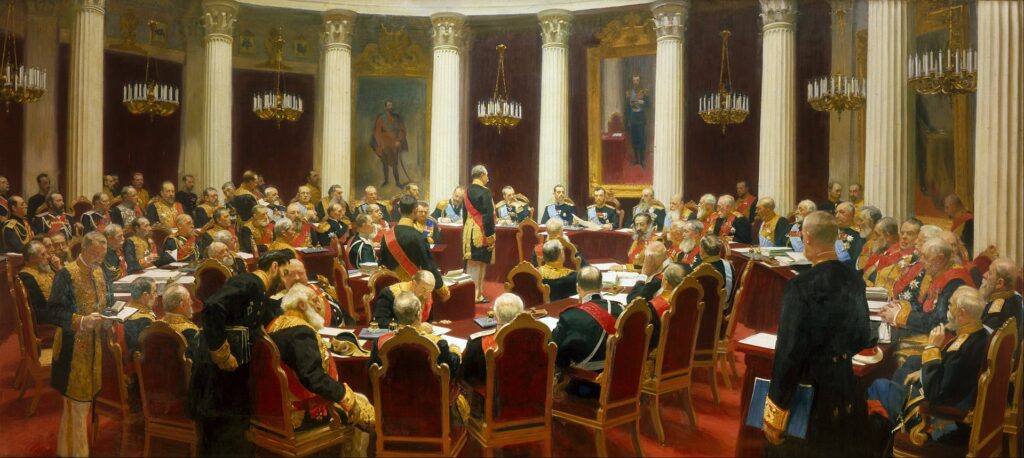
Ceremonial Sitting of the State Council on 7 May 1901 Marking the Centenary of its Foundation. Source: Wikipedia
Repin’s private life
Like by many artists, Ilya Repin’s love life moved swiftly. In 1900 Repin met Natalia Nordman, a very progressive and modern woman. She was a feminist, vegetarian and refused to wear fur. Ilya Repin and Natalia Nordman married and acquired a house called ‘The Penates’ in Koukkala, near Saint Petersburg. However, in 1918 these lands became part of Finland. Despite Repin’s amicable relations with Finnish artists he wanted to go back to the Soviet Union but was uncertain about the new life there. He initially appreciated the first Russian revolution in 1905. Still, the events of the 1917 Revolution and the Bolsheviks’ polical shifts altered his mind. So the old artist decided to stay in Finland. He died on the 29th of September in 1930 at his house ‘The Penates’. Nowadays this house is located in the Russian Federation in the village called Repino (formerely Koukkala, renamed in honor of the artist). The house now hosts the exhibition devoted to the life and work of Ilya Repin. The interiors, furniture, dishes, sketches etc. are authentic, offering visitors a glimpse into the Repin`s era and life.
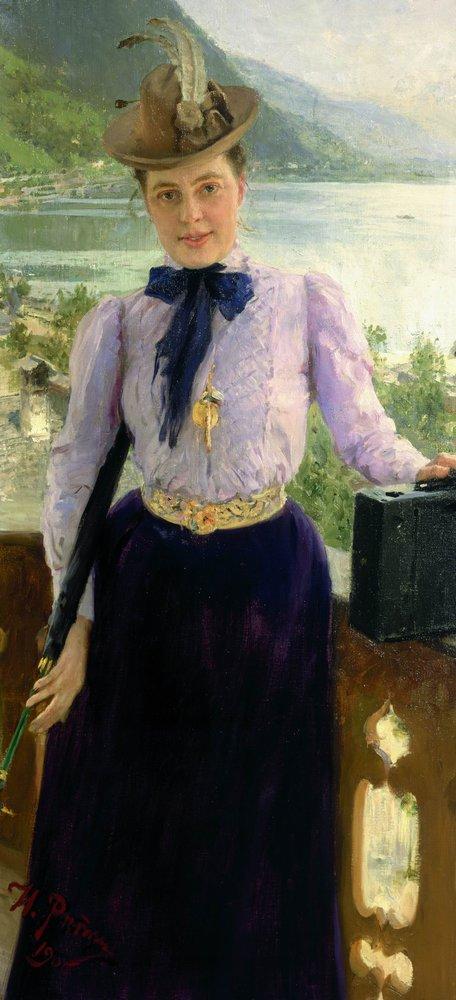
Nordman by Repin 1900. Source: Wikipedia
Ilya Repin also gained recognition as one of the most celebrated and renowned Russian artists abroad. His paintings are frequently exhibited in in the top museums and galleries of Western Europe.
Have you ever seen his artworks? Would you like to visit the real house of the painter?
Let us know in the comments below!
